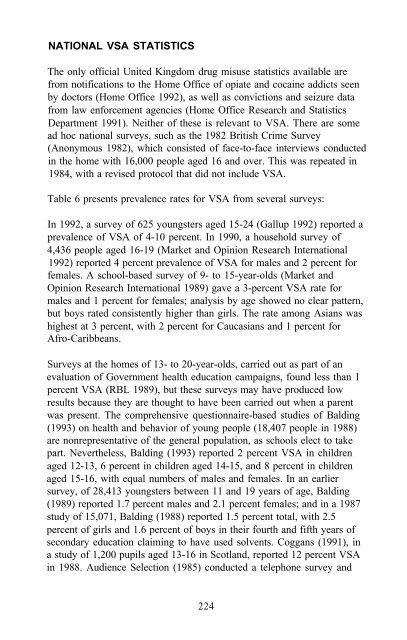Epidemiology of Inhalant Abuse - Archives - National Institute on ...
Epidemiology of Inhalant Abuse - Archives - National Institute on ...
Epidemiology of Inhalant Abuse - Archives - National Institute on ...
You also want an ePaper? Increase the reach of your titles
YUMPU automatically turns print PDFs into web optimized ePapers that Google loves.
NATIONAL VSA STATISTICS<br />
The <strong>on</strong>ly <str<strong>on</strong>g>of</str<strong>on</strong>g>ficial United Kingdom drug misuse statistics available are<br />
from notificati<strong>on</strong>s to the Home Office <str<strong>on</strong>g>of</str<strong>on</strong>g> opiate and cocaine addicts seen<br />
by doctors (Home Office 1992), as well as c<strong>on</strong>victi<strong>on</strong>s and seizure data<br />
from law enforcement agencies (Home Office Research and Statistics<br />
Department 1991). Neither <str<strong>on</strong>g>of</str<strong>on</strong>g> these is relevant to VSA. There are some<br />
ad hoc nati<strong>on</strong>al surveys, such as the 1982 British Crime Survey<br />
(An<strong>on</strong>ymous 1982), which c<strong>on</strong>sisted <str<strong>on</strong>g>of</str<strong>on</strong>g> face-to-face interviews c<strong>on</strong>ducted<br />
in the home with 16,000 people aged 16 and over. This was repeated in<br />
1984, with a revised protocol that did not include VSA.<br />
Table 6 presents prevalence rates for VSA from several surveys:<br />
In 1992, a survey <str<strong>on</strong>g>of</str<strong>on</strong>g> 625 youngsters aged 15-24 (Gallup 1992) reported a<br />
prevalence <str<strong>on</strong>g>of</str<strong>on</strong>g> VSA <str<strong>on</strong>g>of</str<strong>on</strong>g> 4-10 percent. In 1990, a household survey <str<strong>on</strong>g>of</str<strong>on</strong>g><br />
4,436 people aged 16-19 (Market and Opini<strong>on</strong> Research Internati<strong>on</strong>al<br />
1992) reported 4 percent prevalence <str<strong>on</strong>g>of</str<strong>on</strong>g> VSA for males and 2 percent for<br />
females. A school-based survey <str<strong>on</strong>g>of</str<strong>on</strong>g> 9- to 15-year-olds (Market and<br />
Opini<strong>on</strong> Research Internati<strong>on</strong>al 1989) gave a 3-percent VSA rate for<br />
males and 1 percent for females; analysis by age showed no clear pattern,<br />
but boys rated c<strong>on</strong>sistently higher than girls. The rate am<strong>on</strong>g Asians was<br />
highest at 3 percent, with 2 percent for Caucasians and 1 percent for<br />
Afro-Caribbeans.<br />
Surveys at the homes <str<strong>on</strong>g>of</str<strong>on</strong>g> 13- to 20-year-olds, carried out as part <str<strong>on</strong>g>of</str<strong>on</strong>g> an<br />
evaluati<strong>on</strong> <str<strong>on</strong>g>of</str<strong>on</strong>g> Government health educati<strong>on</strong> campaigns, found less than 1<br />
percent VSA (RBL 1989), but these surveys may have produced low<br />
results because they are thought to have been carried out when a parent<br />
was present. The comprehensive questi<strong>on</strong>naire-based studies <str<strong>on</strong>g>of</str<strong>on</strong>g> Balding<br />
(1993) <strong>on</strong> health and behavior <str<strong>on</strong>g>of</str<strong>on</strong>g> young people (18,407 people in 1988)<br />
are n<strong>on</strong>representative <str<strong>on</strong>g>of</str<strong>on</strong>g> the general populati<strong>on</strong>, as schools elect to take<br />
part. Nevertheless, Balding (1993) reported 2 percent VSA in children<br />
aged 12-13, 6 percent in children aged 14-15, and 8 percent in children<br />
aged 15-16, with equal numbers <str<strong>on</strong>g>of</str<strong>on</strong>g> males and females. In an earlier<br />
survey, <str<strong>on</strong>g>of</str<strong>on</strong>g> 28,413 youngsters between 11 and 19 years <str<strong>on</strong>g>of</str<strong>on</strong>g> age, Balding<br />
(1989) reported 1.7 percent males and 2.1 percent females; and in a 1987<br />
study <str<strong>on</strong>g>of</str<strong>on</strong>g> 15,071, Balding (1988) reported 1.5 percent total, with 2.5<br />
percent <str<strong>on</strong>g>of</str<strong>on</strong>g> girls and 1.6 percent <str<strong>on</strong>g>of</str<strong>on</strong>g> boys in their fourth and fifth years <str<strong>on</strong>g>of</str<strong>on</strong>g><br />
sec<strong>on</strong>dary educati<strong>on</strong> claiming to have used solvents. Coggans (1991), in<br />
a study <str<strong>on</strong>g>of</str<strong>on</strong>g> 1,200 pupils aged 13-16 in Scotland, reported 12 percent VSA<br />
in 1988. Audience Selecti<strong>on</strong> (1985) c<strong>on</strong>ducted a teleph<strong>on</strong>e survey and<br />
224
















